Stitch Terms
Aida
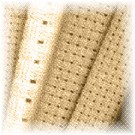
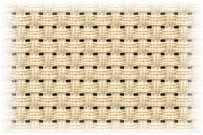
The most commonly used type of fabric for counted cross-stitch. There are many varieties. Threads are woven in groups separated by tiny spaces. This creates a pattern of squares across the surface of fabric and enables a beginning stitcher to easily identify where cross-stitches should be places. Aida cloth is measured by square per inch; 14-count Aida cloth has 14 squares per inch.
Anchor


ANCHOR - A popular brand of thread. One of the main three used in magazines and books. Available in hundreds of colours.
Backstitch
The Backstitch is one of the basic stitches, used mainly for outlining. It is worked in a 'two steps forward, one step back' motion. Usually using just one strand of thread.
Chart
A form of pattern showing the design to be stitched using symbols or colors (representing floss colors, beads, metallic threads and specialty material) on a graph. There are also supplied a legend, which is the listing of what colors of thread or other materials all the symbols mean, a list of materials and the instructions. This is known alternatiely as a Pattern, Graph or Design.
Most cross stitch designs use a chart. The chart is made up of grids of squares-each square representing one stitch.
Color Key
The color key is the list of symbols and corresponding colors that are found on the chart. Most color keys will show the symbol, then the color number found on the skein of floss, then the name of that color.
Count
This refers to the number of threads or holes to the inch (linear) in the fabric. There are two major types: Aida normally comes in 10, 12, 14, 16, 18 threads or holes to the inch; Even-weave normally comes in 24, 26, 27, 28, 30, 32 threads of holes to the inch.
Counted Cross Stitch
Counted" cross stitch is where the fabric is plain (unpatterned), and a pattern or design chart (the graph) shows where each stitch goes. The graph is a grid (of squares representing all the holes of the fabric) showing the relative position and color of each stitch. A legend shows the conversion of symbols used on the chart to the color numbers of the threads, beads, etc. to be used. This is sometimes called Full Counted Cross Stitch.
Cross Stitch
This refers both to the craft itself and to the type of stitch. There are 2 fundamental ways of sewing cross stitch: the Danish method - also called "here and there", where one completes a line of half stitches and then returns to complete the X; and the more traditional method where each cross is completed before starting the next one.
DMC

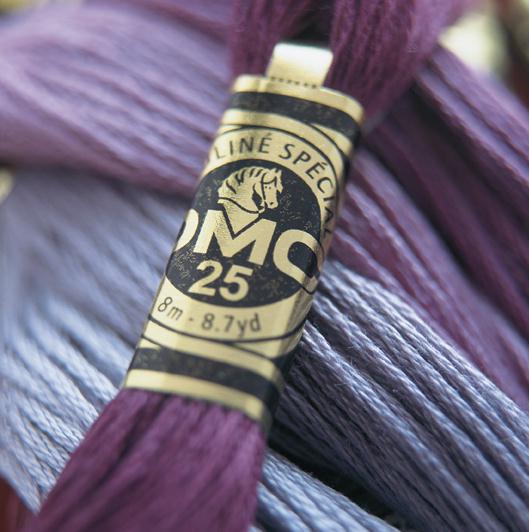
DMC - One of the most popular brands of thread. DMC also manufacture kits, which sell worldwide.
Evenweave
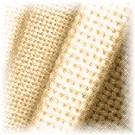
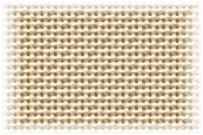
Evenweave fabric is worked over two threads. This means that working on a 28 count evenweave will produce the same size stitch as 14 count Aida.
The popularity of cross-stitch has created a market for specially fabrics for counted cross-stitch. They are referred to as evenweave fabrics because they are woven from threads with a consistent diameter (exactly the same number of threads in each direction), even though some of these fabrics are woven to create a homespun look. Most evenweave fabrics are counted as linen is counted, by threads per inch, and worked over two threads.
Filament

This is like a metallic thread that has been flattened. It comes in many colors, it glitters, and golds and silvers are popular. It is normally sewn using two or three threads of filament in a needle, or with one strand of filament and one or two strands of floss. It is known as a 'blending filament'.
Fractional Stitches
Using three-quarter and quarter stitches can make a great different to a project, enabling you to achieve realistic curves and outlines. Fractional stitches are also used to create more detail within a motif and more subtle shadings of colour.
Fractional stitches are all partly formed cross stitches, or, put another way, cross stitches with missing arms. The most commonly used fractional stitches are three-quarter stitch and quarter stitch, and you will come across these quite frequently on cross stitch charts. In some charts you will also come across half stitches - these are often used to create background detail on a design.
Frogging
Undoing stitches - Rip-it! Rip-it!
Gauge
Gauge - the number of holes per inch (hpi) or threads. The higher the gauge, the finer the fabric. The "gauge" of fabric/canvas and type of fibres affect the size of needle, the type and number of strands of fibre used, the detail of the final design and the length of time for the design to grow.
Graph Paper
If you wish to design your own pictures then graph paper is essential. You can buy ordinary graph paper from stationers or special cross stitching graph paper which comes in various counts such as 14- and 18-counts.
Hoop

An embroidery hoop is a round frame made of wood or plastic. This has an outer and an inner ring that hold your fabric taut while you are stitching. Stitching with a hoop can help to keep your stitches neat and even.
Hoops also come in oval shapes although they are not as common.
Hpi
All cross stitch fabric comes in different counts or holes per inch (HPI). The count of your fabric determines the size of your finished stitching. The lower the count of fabric, the fewer stitches per inch, so the larger the design will be.
Jobelan



Jobelan is an evenweave fabric made from 51% cotton and 49% modal. It has very regularly spaced holes that are easy to see, making it ideal for a first project on evenweave. It drapes well and can be used for table linen as well as samplers and pictures. There are 53 shades to choose from in 28-count jobelan.
Kit
A kit is a collection of all the materials you need to cross stitch a design. Kits usually contain the chart, fabric and threads, specialty threads and beads, a needle, full instructions, and a picture of the finished item.
Linen
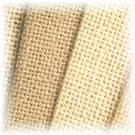

Linen is a fabric made with fibres from the flax plant.
Linen is considered to be the standard of excellence for experienced stitchers. The thread used to weave linen varies in diameter, giving linen fabrics a slightly irregular surface. The thread count of linen is measured by threads per inch, and most designs are worked over two threads, so 28-count linen will yield 14 stitches per inch. Linens are made in counts from 14 (seven stitches per inch) to 40.
Loop Method
This method for anchoring floss only works for even numbers of strands. Do not use when stitching with overdyed or variegated floss. If you are using two strands of floss for cross stitching, start with one strand twice as long as you need. Fold it in half. Thread the needle so the two ends of the floss are near the needle and the "loop" is the end farthest from the needle. Pull the needle up through the fabric where you want to start your first stitch. Do not pull the floss completely through - let loop end dangling a little bit below the cloth. Pull the needle back through the fabric to complete the bottom "half stitch". With the needle back down to the underside, run it through the loop, and gently pull the loop tight. Continue stitching.
Metallic Thread
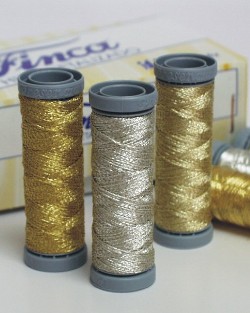
Metallic thread is used to add sparkle to your work - very good for enhancing Christmas cards! Use a shorter length of thread than you would with stranded cotton, as it is more prone to knots.
Needles
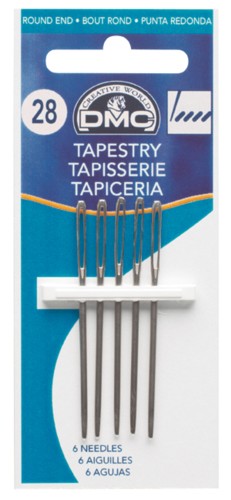
Tapestry needles are used for cross-stitch, as they are blunt, and have a bigger 'eye' for threading the floss through. As well as the more common nickle plated needles, you can also buy gold and platinum ones - although they do cost a bit more!
Size 24 or 26 blunt-pointed tapestry needles are suitable for 14- or 16- count fabrics.
11-count fabric - # 24 (use 3 plies)
14-count fabric - #24 -26 (use 2 or 3 plies)
18-count fabric - #26 (use 2 plies)
22-count fabric - #26 (use 1 ply)
Overdyed Threads
These are specialist threads where a pre-dyed single color thread is taken and 'overdyed' with other colors with stunning results.
Perforated Paper
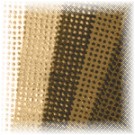
Perforated paper is a thin card that is punched with a grid of holes. It is available in a 14-count and can be stitched just like aida. It is ideal for Victorian-style cards, tree decorations and children's mobiles. Use three strands for the best coverage and handle it gently because it can tear.
Petit Point
This refers to both the needlecraft and the canvas. The canvas is very fine with more than 17 or more holes per inch. The needlecraft uses tent stitch in wool or silk on Petit Point canvas to achieve fine detail and wonderful shading.
Plastic Canvas
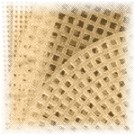
A rigid mesh of plastic to be stitched on. Ideal for making magnets or Christmas tree ornaments and for rigid projects like boxes and tags.. Comes in small sheets of various shapes and in various counts and sizes.
Quilting
Quilting is a technique of sewing through multiple layers of cloth in lines or patterns to fix them together, often with padding in between.
Q-Snap Frames
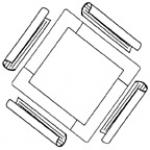
Invented and developed by a quilter, Monta Lea Kramer, The Q-SNAP is based on the simple, no-nonsense concept of interchangeable lengths of PVC pipe which can be easily assembled to your required work size. Your fabric is rolled around the curve of the pipe and held tautly in place with a clip that conforms to the curve of the pipe. No more crinkling of your fabric in a hoop or stapling it to a stretcher bar.
Rice Stitch
Rice stitch is a variation on simple cross stitch. On an open or larger holed fabric it gives the appearance of denser cover, because the reverse side stitching shows through more. It can also be used to produce interesting textures using subtly different all highly contrasting color.
Running Stitch
Running stitch - a straight line of stitches used as an outline or frame for more complicated stitches.
Sewing Method
The sewing method is used by stitchers who prefer to hold the fabric in the hand instead of in a hoop.
The stitcher's hand and needle stay on top of the fabric, except when securing floss. The needle is brought to the upside of the fabric. For doing the stitch properly, it is inserted into the fabric and brought back to the surface in one movement. Then the thread is pulled through. The same method is used for plain hand sewing.
This method can be done using an embroidery frame or free-hand, but in many cases the use of an embroidery frame or hoop will make the work easier. It needs to be a frame that allows for adjustment of fabric tension, because the fabric mustn't be too strongly stretched in order to allow inserting the needle without pulling the fabric too much.
Six-Strand Embroidery Floss
Embroidery floss is a cotton thread used for stitching. Floss has 6 strands, but usually you will use only 2 strands at a time for stitching and 1 strand for backstitching. On Hardanger fabric (22 count) you usually will use only 1 strand; on 11 count Aida use 3 strands to stitch and 2 to backstitch. Most books and patterns suggest either DMC or Anchor brands, which are easy to find at your local craft store.
Skein of Embroidery Floss
A skein is a bundle of six-strand embroidery floss about 8 yards long. The skein is held together by small paper tubes on which the brand and color number are printed.
Stab Method
Stab Method of Cross Stitching is used by most beginning stitchers. The stab method involves moving the hand back and forth from the front of the fabric to the back of the fabric. The needle is "stabbed" into the front of the fabric, left there, and then pulled through from the other side.
For this a frame or hoop should be used. It can be done faster if the hoop or frame is somehow mounted, so that both hands are free for the embroidery. Then, the dominant hand is held under the fabric, the non-dominant hand above it. The needle is handled by each respective hand without necessity for hand position changes
Stash
STASH - a nickname for your collection of kits, charts and projects.
Stranded Cotton
This is the most popular thread used for cross stitch and is sold as a skein. The thread is made up of six divisible strands. Pull out one, two or more strands to stitch a design, as directed in the key.
Threads

Most cross stitch designs are stitched with stranded embroidery cotton. This is a divisible thread made up of six strands. You can use all six or pull out as many strands as instructed in the key. Designs stitched on 14-count aida are usually worked in two strands.
Unbleached Thread
Unbleached threads are available for stitchers wishing to experiment at dying their own threads
Variegated Thread
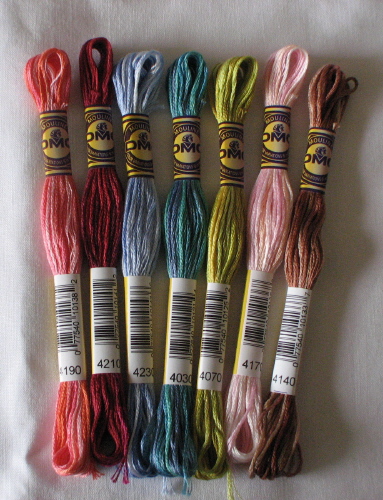
On a skein of variegated thread the color continually changes from light to dark and back to light again along the length of the thread. A subtle and interesting effect can be created by using this thread to work a block of cross stitches.
Vinyl Weave


Vinyl-Weave (or Vinyl Aida) can be cut, shaped, and folded offering a novel approach to your stitchery projects! It does not ravel, wrinkle, or tear. It is great for mousepads, placemats, coasters, ornaments, magnets, and an unlimited number of small projects. Most acrylic items use vinyl-weave or vinyl aida for the stitching area.
Available in 6, 14, or 18 count and offered in a great variety of colors.
Waste Canvas
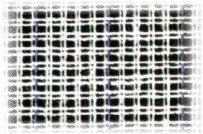
This is made to allow cross stitching to be done on non-evenweave fabrics. Waste canvas has counts of anything from 6 upwards, and can be used like Aidas or even-weaves. Threads held together by starch. The waste canvas is attached to the parent article, and cross stitched. At the end, the strands of waste canvas are pulled out, leaving the pattern on the parent piece. Dampen to remove starch and extract threads with tweezers. Do not use a sharp needle or you will pierce the canas and not be able to pull the strands out.
Waste Knot
A waste knot is sometimes used when beginning a cross stitch. A knot is tied in the end of the floss. This waste knot stays on the top of the evenweave fabric, keeping the floss from being accidently drawn out as the first stitches are done. After the first few stitches are complete, the waste knot is cut away and the end of the floss is secured under the back of the stitches.
X.Stitch
X-Stitch is a nickname for cross stitch.
Yarn
A cord of twisted or spun fibres. A thick cord is known as string, or rope; a thinner, more pliable cord is known as yarn, and is often used in knitting and weaving; a very thin cord is known as thread, and is used in fine weaving and sewing.
Zweigart
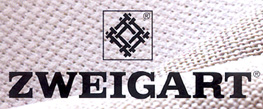
Zweigart is a well known manufacturer of stitching fabric. There are a fantastic range of colours, fabrics and count.
